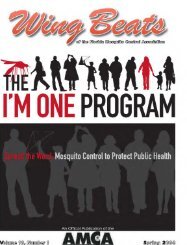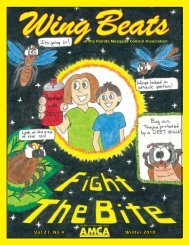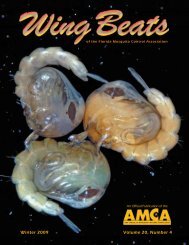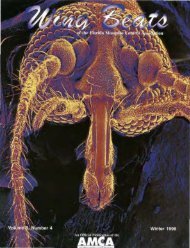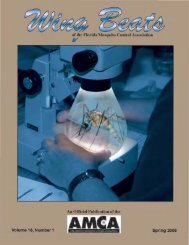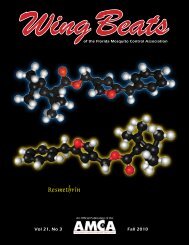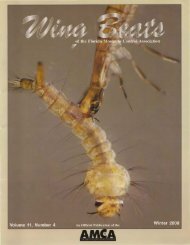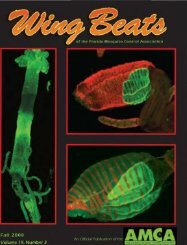27 - Wing Beats - Florida Mosquito Control Association
27 - Wing Beats - Florida Mosquito Control Association
27 - Wing Beats - Florida Mosquito Control Association
Create successful ePaper yourself
Turn your PDF publications into a flip-book with our unique Google optimized e-Paper software.
.. '<br />
Volume 15, Number 3<br />
of the <strong>Florida</strong> <strong>Mosquito</strong> <strong>Control</strong> <strong>Association</strong><br />
..<br />
. . "'<br />
..<br />
An Official Publication ofthe<br />
• \<br />
Fall 2004
Out-of-this-World<br />
Selection and Service.<br />
B&G is your one-stop source for mosquito control<br />
supplies, equipment & repair services ...<br />
• Adulticides • Equipment • Seminars • Technical Support<br />
• Larvicides • Accessories • Repairs • Pest <strong>Control</strong> Supplies<br />
- -<br />
B&G Chemicals & Equipment Co., Inc.<br />
1·800-345-9387 bgchem.com
Sticky trap with<br />
mosquitoes on it.<br />
six morerew members were<br />
added to the initial four, making the<br />
USDS project a specialty team to<br />
target a singular source, unprecedented<br />
within an urban district the<br />
size of GLACVCD. The expansion<br />
was justifiable since West<br />
Nile virus positive mosquitoes<br />
were discovered in the USDS<br />
shortly after the program was<br />
implemented. By attacking<br />
overwintering<br />
adult mosquito populations<br />
in these subterranean<br />
sources and<br />
then continuing an intense<br />
larvicidal program<br />
throughout the<br />
mosquito season, the<br />
District aims to<br />
achieve a threshold of<br />
"no disease transmission"<br />
from the USDS.<br />
Another reason for expansion<br />
was to conduct<br />
effective mosquito<br />
surveillance of<br />
over 10,000 miles of<br />
storm drains and<br />
more than 90,000<br />
catch basins, to determine<br />
problematic<br />
USDS, which could<br />
not be effectively accomplished<br />
with four<br />
crewmembers.<br />
Surveillance is conducted<br />
to determine<br />
mosquito population<br />
densities by setting<br />
Trash in the USDS.<br />
Encephalitis Virus Surveillance<br />
(EVS) baited traps placed into each<br />
system just below the manhole<br />
cover as well as sticky traps used<br />
to collect adult mosquitoes. During<br />
the program's first year, 25 miles of<br />
mosquito surveillance and control<br />
were performed. Now, with additional<br />
staff, over 200 miles of USDS<br />
are inspected monthly. The USDS<br />
Treating the USDS.<br />
USDS crew placing<br />
sticky trap.<br />
crew is trapping more frequently to<br />
obtain and submit adult mosquitoes<br />
for West Nile virus testing.<br />
There are not enough data toestablish<br />
a threshold of what is considered<br />
low to high mosquito<br />
populations in the USDS. From<br />
last year's data, problem USDS<br />
have been determined, and the crew<br />
maintains a watchful eye<br />
on these systems, keeping<br />
the mosquitoes well under<br />
control.<br />
After surveillance is conducted<br />
and if mosquitoes<br />
are found in the USDS,<br />
treatment shortly follows<br />
by applying larvicidal control<br />
agents, such as<br />
Vectobac 12AS, combined<br />
with Vectolex<br />
WDG. The use of these<br />
highly selective biological<br />
larvicides will be interchanged<br />
to prevent resistance<br />
problems. The application<br />
is in the form of<br />
an aerosol/fog mist, which<br />
is injected into the USDS<br />
using the "LAvector/<br />
USDS Larvicide Applicator."<br />
This modified applicator<br />
consists of an Amflo<br />
Hydro blast cleaning tool<br />
and siphon, used for highpressure<br />
steam cleaning<br />
of auto engines. This unit<br />
is attached to an air com<br />
'Jf/'"9 i$'eaU. Fall 2004 11
From where I sit. .. A number of items<br />
of particular interest have occurred on<br />
the legislative front since the AMCA<br />
Washington Legislative Conference in<br />
May.<br />
First, a legislative aide to Senator Richard<br />
J. Durbin (D-IL), requestedAMCA<br />
assistance in briefing the senator on the<br />
EPArulemaking regarding NPDES issues<br />
that the AMCA has been pursuing<br />
at length. This is a direct outgrowth of<br />
Mark Newberg's (Wellmark International)<br />
visit to the senator's office during<br />
the recent Washington Legislative<br />
Conference. During my phone conversations<br />
w ith the legislative aide, it<br />
became increasingly clear to her that<br />
the issue was both a complicated an<br />
important one, w ith a long and convoluted<br />
history. After forwarding her a<br />
number of documents meant to clarify<br />
the issue, I received a request that I<br />
assist in writing an issue letter for Sen.<br />
Durbin's signature. Senator Durbin's<br />
staff has some issues about the safety<br />
issues surrounding pesticide use, mostly<br />
as a result of local public health officials<br />
being squeamish about the known<br />
and unknown environmental effects of<br />
insecticides. I disabused the senior legislative<br />
aide of some of her more egregious<br />
myths regarding the toxicology of<br />
public health insecticides, but she still<br />
appeared to harbor misgivings that won't<br />
be easily dislodged by facts. Nonetheless,<br />
Senator Durbin's office has since<br />
forwarded the letter supporting the<br />
NPDES exemption to EPAAdministrator<br />
Leavitt. My thanks to Mark for soliciting<br />
and successfully obtaining Senator<br />
Durbin's assistance in this critical<br />
matter. This underscores the critical<br />
role that congressional visits can make<br />
in the legislative process in addition to<br />
reemphasizing the need for legislator<br />
access to sound science.<br />
Secondly, the U. S. Fish and W ildlife<br />
Service (USFWS) and the National<br />
14 Fall 2004<br />
From Where I Sit<br />
Marine Fisheries Service (NMFS) of the<br />
National Oceanic andAtmosphericAdministration<br />
(NOAA), have finalized new<br />
regulations establishing a more efficient<br />
approach to ensure compliance with<br />
Section 7 of the Endangered Species<br />
Act (ESA) as part of the U.S. Environmental<br />
Protection Agency's approval<br />
process for pest control products. The<br />
regulation was published August 5, 2004.<br />
The AMCA had expressed its support<br />
of the initial proposal for the counterpart<br />
regulation in a letter to Gary Frazer,<br />
Assistant Director for Endangered Species,<br />
U.S. Fish and Wildlife Service on<br />
February 11 of this year.<br />
The streamlined review procedures,<br />
developed in cooperation with EPA and<br />
the U.S. Department of Agriculture, w ill<br />
provide a workable and efficient framework<br />
to ensure necessary measures are<br />
taken to protect fish and wildlife. At the<br />
same time, the procedures w ill ensure<br />
that mosquito control products will continue<br />
to be available for use by public<br />
health authorities. These counterpart<br />
regulations now specify that:<br />
· The EPA, utilizing the most sophisticated<br />
methodologies available, can<br />
determine that the use of a mosquito<br />
control product is "not likely to adversely<br />
affect" a listed species or its<br />
critical habitat without either concurrence<br />
of the Services or consultation.<br />
In order to ensure EPA is making determinations<br />
that are consistent with<br />
the requirements of the ESA, the<br />
Agencies are authorized to periodically<br />
review the methodologies utilized<br />
by EPA to arrive at these determinations.<br />
· When formal consultation is required,<br />
EPA may request direct involvement<br />
of the Services in the effects<br />
analysis. As required by law,<br />
the Services would then make the final<br />
determination whether threatened<br />
or endangered species are likely to<br />
be jeopardized by a FIFRA action.<br />
Thirdly, after extensive consultation with<br />
AMCA members and member agencies,<br />
the AMCA provided comments to the<br />
Draft Pesticide Registration (PR) Notice<br />
2004 - XX, "Labeling Statements on<br />
Products Used for Adult <strong>Mosquito</strong> <strong>Control</strong>."<br />
We were aware that, although our<br />
recommendations reflected the preponderance<br />
of thought on the subject by<br />
the membership, w e wouldn't please<br />
everyone % and, indeed, we didn't. The<br />
comments are posted on the AMCA<br />
website and consist of our responses<br />
to the 7 recommendations for label<br />
changes posted by the EPA. The label<br />
changes posited by the EPA with a brief<br />
explanation of our comments as posted<br />
on the website are listed below.<br />
Recommendation 1. "For use only by<br />
federal, state, tribal, or local government<br />
officials responsible for public<br />
health or vector control, or by persons<br />
certified in the appropriate category<br />
or otherwise authorized by the<br />
state or tribal lead pesticide regulatory<br />
agency to perform adult mosquito<br />
control applications, or by persons<br />
under their direct supervision."<br />
AMCA: We felt that the certification<br />
requirements for government officials<br />
needed clarification to avoid giving<br />
the impression that they were notrequired<br />
(" .. . or by persons certified<br />
... "). We also wanted it stipulated<br />
as to whether "direct supervision"<br />
included that via telecommunication.<br />
Recommendation 2. Products labeled<br />
for wide-area adult mosquito<br />
control should not include container<br />
labeling for uses unrelated to mosquitoes.<br />
The standard terrestrial use<br />
water hazard statement should not<br />
appear on product containers labeled<br />
solely for mosquito control. If
a container label includes non-mosquito<br />
control use directions, those<br />
directions and associated precautions<br />
should be clearly distinguished<br />
from those applicable to mosquito<br />
control. The terrestrial use statements<br />
on a mixed-use label should<br />
be followed by the statement “See<br />
separate directions and precautions<br />
for mosquito control applications.”<br />
AMCA: We endorsed this recommendation,<br />
but felt that the term<br />
“...wide-area adult mosquito control...”<br />
gave a somewhat negative impression<br />
and recommended it be<br />
amended to “…both terrestrial and<br />
aerial adult mosquito control…”<br />
Recommendation 3. “This pesticide<br />
is [toxic/extremely toxic] to aquatic<br />
organisms, including [insert types of<br />
organisms]. Runoff from treated areas<br />
or deposition of spray droplets<br />
into a body of water may be hazardous<br />
to [insert types of organisms].<br />
[If appropriate, insert any additional<br />
wildlife hazard statements]. [Bee<br />
precaution can be inserted here or<br />
as a third paragraph of this section<br />
of the label]. [Insert consultation with<br />
state/tribal agency statement].<br />
“Do not apply over bodies of water<br />
(lakes, rivers, permanent streams,<br />
natural ponds, commercial fish<br />
ponds, swamps, marshes or estuaries),<br />
except to target areas where<br />
adult mosquitoes are present. Do<br />
not contaminate bodies of water<br />
when disposing of equipment<br />
washwaters .”<br />
AMCA: We made the point that modern<br />
adulticiding utilizes extremely<br />
small amounts of pesticides that are<br />
drifted through an area, with little<br />
deposition or runoff as a means to<br />
place aquatic issues within a proper<br />
perspective supported by scientific<br />
fact. We felt that the [toxic/extremely<br />
toxic] term was unduly emotive in light<br />
of known effects from actual exposures<br />
to labeled adulticides. Nonetheless,<br />
in light of potential hazards<br />
from misuse that need to be addressed<br />
on the label, we felt that the<br />
No Observed Adverse Effect Level<br />
(NOAEL) on the most susceptible<br />
listed organism would provide a reasonable<br />
standard. The NOAEL is already<br />
available in registrant data and<br />
shouldn’t entail a further burden on<br />
the registrant. We further stated that<br />
it would make sense to express this<br />
in terms of its relation to actual application<br />
rates in order to quantify true<br />
risk.<br />
Feeling that the EPA could more tangibly<br />
support its registration process<br />
through the label, we suggested that<br />
a general statement stating that the<br />
product would not pose an unacceptable<br />
risk if used according to label<br />
specifications be added in lieu of the<br />
emotive terms. Certainly, the EPA<br />
tacitly stated this when registering the<br />
product. Thus, the entire issue of<br />
listed NOAELs and susceptible species<br />
would become moot.<br />
Recommendation 4. “Before making<br />
the first application in a season, it<br />
is advisable to consult with the state<br />
or tribal agency with primary responsibility<br />
for pesticide regulation to<br />
determine if permits or other regulatory<br />
requirements exist.”<br />
AMCA: We took issue with the use<br />
of the phrase “permits or other” because<br />
of its possible linkage with the<br />
NPDES issue beyond the 9 th Circuit<br />
Courts jurisdiction.<br />
Recommendation 5. “Equipment<br />
should be calibrated so that no more<br />
than [percentage to be provided by<br />
registrant] % of the spray volume is<br />
contained in droplets larger than 50<br />
microns (mm) in diameter and no<br />
more than [percentage to be provided<br />
by registrant] % is contained<br />
in droplets larger than 100 microns<br />
in diameter. For aerial applications,<br />
calibration must account for the effects<br />
of flight speed and nozzle angle<br />
on droplet size under application<br />
conditions. For aerial application<br />
equipment, directions from the<br />
equipment manufacturer provide the<br />
best guidance and should be used<br />
for droplet size calibration. Droplet<br />
size measurements made by applicators<br />
using slides, paper, or other<br />
surfaces should not be used in lieu<br />
of the manufacturer’s instructions for<br />
calibrating equipment to the required<br />
droplet size, but should be used<br />
regularly to ensure that equipment<br />
is performing consistently from application<br />
to application.”<br />
AMCA: We found the section to be<br />
somewhat objectionable due to its<br />
seeming sole focus on aerial applications<br />
and flat fan nozzles. We also<br />
recommended that calibration instructions<br />
be provided by either the<br />
spray equipment’s manufacturer or<br />
a vendor of such equipment and cited<br />
the Fyfanon® ULV label from<br />
Cheminova as an excellent template<br />
for a comprehensive, informative label.<br />
This label allows for flexibility,<br />
while specifying relevant application<br />
parameters such as MMD, maximum<br />
droplet size allowed, and a range<br />
within which two-thirds to three-quarters<br />
of the droplets must fall. Furthermore,<br />
the Fyfanon® ULV label provides<br />
thorough directions for achieving<br />
the required droplet spectra via<br />
ground and aerial means in addition<br />
to determining droplet size using several<br />
different media.<br />
Recommendation 6. “[. . . when bees<br />
are visiting the treatment area], except<br />
when applications are made to<br />
prevent or control an imminent threat<br />
to public and/or animal health declared<br />
by state, tribal or local health<br />
or vector control agency, or if specifically<br />
approved by the state or<br />
tribe during a natural disaster recovery<br />
effort.”<br />
AMCA: We asked that the label language<br />
specify “[…applications to<br />
food crops or weeds when bees are<br />
visiting the area…]” to address a restriction<br />
that effects mosquito control<br />
applications more than actual bee<br />
restrictions.<br />
Recommendation 7. “Do not retreat<br />
a site more than once in [X hours/<br />
days]; no more than [Y] applications<br />
should be made to a site in any [Z<br />
weeks/months] or [one year]. More<br />
frequent treatments may be made<br />
to prevent or control an imminent<br />
threat to public and/or animal health<br />
declared by state, tribal or local<br />
health or vector control agency, or if<br />
specifically approved by the state or<br />
<strong>Wing</strong> <strong>Beats</strong><br />
Fall 2004<br />
15
tribe during a natural disaster recovery<br />
effort."<br />
AMCA: This recommendation drew<br />
the most varied response from among<br />
those who submitted comments.<br />
Some felt that specifying retreatment<br />
parameters unduly limited applicator<br />
flexibility in meeting changing control<br />
requirements. Others felt that the<br />
administrative burden this would entail<br />
would overtax districts already<br />
operating on slim margins in terms<br />
of resources.<br />
The issue is complex, given application<br />
timings governed by the varying<br />
susceptibilities of non-targets at certain<br />
stages of their development. In<br />
addition, what constitutes acceptable<br />
environmental loads in light of ESA<br />
issues, product chemistry, persistence<br />
and environmental fate have<br />
not been adequately defined, in some<br />
instances, to the point of precluding<br />
challenge. The fact is that removing<br />
all retreatment restrictions would not<br />
be acceptable to either the EPA or to<br />
the many environmental groups with<br />
the means to legally challenge their<br />
absence.<br />
We felt that the EPA risk models provide<br />
the most consistent means by<br />
which retreatment issues could be<br />
addressed as long as public health<br />
needs were taken into account. To<br />
this end, AMCA recommended that<br />
applications of materials may be repeated<br />
as required based on surveillance<br />
data or epidemic risk established<br />
by recognized competent authority.<br />
We recommended that this<br />
be restricted to a maximum label rate<br />
within a 24 hour period or a maximum<br />
amount per acre per year based<br />
upon registrant-developed NOAELs<br />
and EPA Risk Assessments (RA).<br />
AMCA felt that districts already track<br />
application parameters, so that administrative<br />
overhead should not be<br />
significantly increased. Furthermore,<br />
NOAEL levels are extremely unlikely<br />
to be approached in even exceptional<br />
public health circumstances if application<br />
rates are followed. Yearly load<br />
restrictions would be determined by<br />
EPA RAs already in place. We are<br />
convinced that these restrictions will<br />
in no way hinder districts utilizing the<br />
full range of control methodologies<br />
within accepted integrated mosquito<br />
management frameworks.<br />
AMCA will continue to monitor legislative<br />
and regulatory issues to ensure the<br />
interests of the mosquito control profession<br />
are ably served. I would also<br />
solicit your input into this process when<br />
asked. To be sure, theAMCAprovides<br />
a credible perspective to these issues<br />
within our limited capacity. But our footprint<br />
in the Agencies and halls of Congress<br />
considerably enlarges to the extent<br />
that all of our members take the<br />
time to participate in this critical arena.<br />
For instance, activist groups evidently<br />
coordinated the mailing of several hundred<br />
thousand letters to EPA regarding<br />
the ESA issue. That they could mobilize<br />
this level of response is impressive,<br />
despite the Agency's eventually ruling<br />
with us on the issue, speaks to the nature<br />
of our opposition. We would do<br />
well to demonstrate the same level of<br />
commitment<br />
One of the functions of the<br />
AMCAis to represent the<br />
mosquito control point of view<br />
to government agencies and<br />
environmental organizations.<br />
Joe Conlon, the AMCA<br />
Technical Advisor, keeps us up<br />
to date on congressional and<br />
environmental actions related to<br />
mosquito control.<br />
SOUTHWEST ASSURANCE CORP OF FL/ AMMIA<br />
16 Fall2004<br />
THE PREFERRED INSURANCE PROGRAM<br />
HOW MUNICIPALITIES AND TAXING DISTRICTS CONTAIN THE HIGH COST OF INSURANCE PROTECTION<br />
GENERAL LIABILITY*** PROFESSIONAL LIABILITY*** AUTOMOBILE LIABILITY<br />
AVIATION LIABILITY*** AVIATION HULL ***AVIATION CHEMICAL LIABILITY<br />
SOUTllWEST ASSURANCE CORPORATION OF FL (PROGRAM ADMINISTRATORS)<br />
401 EAST JACKSON STREET, SUITE 1700 TAMPA, FLORIDA, 33602<br />
PHONE: 800-5<strong>27</strong>-4953 FAX: 813-222-4040<br />
AM CA, Sustaining 1lfember<br />
... ,
Introducing a new_wave<br />
for environmental science.
Introducing a new_wave<br />
for environmental science.
The Entomological Foundation is<br />
focusing its efforts on conducting<br />
a national inventory to determine<br />
what IPM youth educational programs<br />
and materials exist and<br />
bring together those organizations<br />
that have a high stake in these resources.<br />
Its newest initiative, Educating<br />
Young People About Responsible<br />
Pest Management for<br />
a Sustainable Environment, is the<br />
result of the formation of new partnerships<br />
to increase the capacity<br />
of youth educators to incorporate<br />
IPM programming into current formal<br />
and informal science-based<br />
educational programs. AMCA<br />
members are often involved in<br />
youth educational resources and<br />
your experience in the use of IPM<br />
for mosquito control is of great interest<br />
to the Foundation's national<br />
initiative.<br />
The Entomological Foundation<br />
would like to summarize the available<br />
resources and identify opportunities<br />
for curriculum development,<br />
which will determine where<br />
future youth IPM funding resources<br />
could best be applied. As<br />
part of this national initiative, a onestop<br />
IPM Education virtual library<br />
(web-based) will be developed.<br />
This library will contain identified<br />
IPM educational programs and<br />
materials for parents, educators,<br />
and young people who want to<br />
teach and learn about the environment<br />
and the extreme importance<br />
of responsible pest management.<br />
The Foundation urges AMCA<br />
members to join this effort as mosquito<br />
breeding and control is an<br />
Entomological Foundation<br />
Seeks AMCA Members<br />
in its Network of Partners<br />
essential area of this educational<br />
program.<br />
Roles and responsibilities of the<br />
Entomological Foundation's partners<br />
include reviewing curriculums,<br />
setting up pilot projects in<br />
communities where universities,<br />
counties, and private sector partners<br />
have sites, and serving on<br />
an advisory committee, along<br />
with planning and implementing<br />
regional teacher and informal<br />
youth educator development<br />
training. state teams of teachers<br />
and volunteers/informal youth<br />
educators including 4-H program<br />
leaders, home-schooling parents,<br />
and representatives from<br />
other youth-serving organizations<br />
will be trained in the use of the<br />
resulting resources and materials.<br />
Workshop participants will be<br />
asked to train others in their state<br />
on how to provide science activities<br />
for youth including the development<br />
and implementation of<br />
community-based insect/mosquito<br />
science programs.<br />
The Entomological Foundation,<br />
a not-for-profit educational organization,<br />
is dedicated to serving<br />
the educational enterprise by leveraging<br />
science-community resources<br />
to educate youth in applying<br />
insect science to achieve<br />
a healthy environment. The Entomological<br />
Foundation is forming<br />
a network of science-based<br />
partners from the public and private<br />
sectors concerned with integrated<br />
pest management, environmental<br />
and entomological<br />
education.<br />
Partners in this national initiative now<br />
include Agriculture in the Classroom,<br />
Dow AgroSciences, National <strong>Association</strong><br />
of Biology Teachers, National<br />
4-H, National Science Teachers <strong>Association</strong>,<br />
North American <strong>Association</strong><br />
for Environmental Education,<br />
Orkin Technical Services, Pennsylvania<br />
State University, and University<br />
of California- Davis. The Entomological<br />
Foundation would like to<br />
have AMCA members to be partners<br />
in this endeavor.<br />
If you would like to learn more about<br />
the program and how you can support<br />
this endeavor, see the<br />
Foundation's web site http://<br />
www.entfdn.org. To learn more<br />
about the Foundation and how it can<br />
help you; or contact April Gower,<br />
Executive Vice President, Entomological<br />
Foundation, (301 ) 459-9083.<br />
Fred Knapp<br />
Assistant<br />
Director Emeritus<br />
Professor Emeritus<br />
Department of Entomology<br />
University of Kentucky<br />
Immediate Past<br />
President AMCA<br />
16'"9 r?eaU Fall 2004 25
to d isease outbreaks<br />
faster and more accurately.<br />
With the deployment of<br />
the handheld field data<br />
collection unit (e.g., a<br />
Trimble GeoXT) with<br />
ArcPad, field technicians<br />
and supervisors are able<br />
to collect surveyed coordinates<br />
for a variety of<br />
data. Some frequently<br />
used applications include<br />
the Inspector's forms to<br />
monitor the collection sites<br />
for mosquito larvae and<br />
areas treated with larvicide<br />
(Figure 2).<br />
The ArcPad forms expedite entering<br />
required data that was previously<br />
recorded on paper and<br />
then manually entered into a database<br />
upon returning to the main<br />
office. This new handheld pocket<br />
pc enables the inspector or field<br />
technician to enter more detailed<br />
site data, record georeferenced<br />
positions, and display the sites<br />
on a reference map (Figure 3).<br />
The immediate capture of environmental<br />
conditions and the potential<br />
mosquito breeding habitat<br />
locations simplifies the process<br />
of recording accurate<br />
data. This in turn expedites<br />
disease surveillance<br />
and monitoring with a reduced<br />
potential for error.<br />
HCMC is uniquely organized<br />
to operate as a series<br />
of systems. Laboratory<br />
personnel act in concert<br />
with field personnel<br />
to collect mosquitoes and<br />
birds for disease surveillance,<br />
as well as conduct<br />
on-site testing and evaluations.<br />
The Test and<br />
Evaluation (T & E) labo-<br />
Figure 2<br />
Figure 3<br />
Handheld field data collection unit<br />
ratory assesses commercially<br />
manufactured<br />
mosquito trap endurance<br />
and effectiveness<br />
for mosquito abatement<br />
and surveillance. In addition,<br />
the T& E laboratory<br />
conducts resistance<br />
testing of commercially<br />
available pesticide<br />
products.<br />
Resistance testing utilizes<br />
a grid comprised<br />
of three rows of polemounted<br />
cages spaced<br />
1 00 feet apart on each<br />
row. The rows are<br />
placed 1 00 feet apart creating a<br />
200 by 300 foot grid. Each of the<br />
nine poles of the grid holds two<br />
cages that contain a precise<br />
count of Culex quinquefasciatus<br />
mosquitoes, the main vector species<br />
of St. Louis Encephalitis and<br />
West Nile virus in the region. One<br />
cage contains the test mosquitoes<br />
collected from field populations<br />
and the second cage contains<br />
a susceptible strain of colony<br />
mosquitoes. This method allows<br />
researchers the opportunity to determine<br />
if the mosquito populations<br />
breeding in specific areas<br />
of Harris County are becoming resistant<br />
or less sensitive<br />
to pesticides.<br />
Once the grid is set, the<br />
poles are individually<br />
georeferenced using the<br />
Trimble GeoXT handheld<br />
field data collection unit.<br />
Custom ArcPad forms<br />
are vital for this purpose.<br />
The unique identifying information<br />
and GPS point<br />
is simultaneously recorded<br />
for each pole site<br />
using these forms.<br />
The next step in the resistance<br />
testing is the in-<br />
'Jf/'"9 i$'eaU. Fall 2004 35
troduction ofthe pesticide. In this<br />
region, the ultra-low volume<br />
(ULV) spray truck is the most<br />
commonly used application<br />
method. The spray truck is driven<br />
at five miles per hour past the grid<br />
in a path perpendicular to the prevailing<br />
winds, so that the plume<br />
of pesticide is carried through the<br />
grid of poles. After the drift has<br />
dissipated, the mosquitoes are<br />
collected from the cages and<br />
observed during the following<br />
days in the laboratory, where<br />
mortality rates are noted for each<br />
site. The use of georeferenced<br />
data helps ensure the accuracy<br />
of the grid setup and drive path<br />
for the spray truck. The data recorded<br />
at each pole site is then<br />
used to analyze and display the<br />
sensitivity of the mosquitoes at<br />
each site to specific pesticides.<br />
Although this project was not included<br />
in the original mobile government<br />
grant proposal, it has<br />
proven to be one ofthe most beneficial<br />
uses of the grant.<br />
The advantages of field data collection<br />
are used in several HCMC<br />
sections; Inspection, Test and<br />
Evaluation, <strong>Mosquito</strong> Surveillance<br />
and Avian Surveillance. Several<br />
ArcPad forms have been created<br />
for specific purposes (Figure 7).<br />
While each HCMC section is<br />
unique in its function and collection<br />
techniques, they each gather<br />
point data. During the initial planning<br />
of the field data collection<br />
forms each section requested a<br />
simple form that could easily be<br />
completed in the field and<br />
seamlessly record the same data<br />
they were entering in the office.<br />
Data management has been improved<br />
by using data tables<br />
stored in Microsoft Access databases<br />
created by each section.<br />
These data tables store detailed<br />
data for each sample collected<br />
and each site visited. The ArcPad<br />
36 Fall2004<br />
forms developed for each section<br />
were simple and create a file<br />
(i.e. dbf) that can be downloaded<br />
easily and integrated into the existing<br />
databases since the fields<br />
used in the forms correspond to<br />
those already being used in the<br />
existing database. Building on the<br />
present database format, the<br />
ArcPad forms were easily deployed<br />
to field personnel already<br />
familiar with the data they had to<br />
collect.<br />
Harris County <strong>Mosquito</strong> <strong>Control</strong><br />
has been aggressive in the implementation<br />
of an active and updated<br />
geographic information<br />
system. They strive to build better<br />
datasets and share valuable<br />
data with other agencies in a<br />
timely manner. As a part of the<br />
Harris County Health department<br />
and as part of the greater Harris<br />
County area, Harris County <strong>Mosquito</strong><br />
<strong>Control</strong> actively promotes<br />
the use of GIS in all aspects of<br />
surveillance, analysis, and reduction<br />
of disease occurrence. For<br />
more information please visit our<br />
website at<br />
www.harriscountyhealth.com or<br />
email Christina Hailey at<br />
chailey@harriscountyhealth.com.<br />
,----------<br />
Christina Hailey<br />
GIS Coordinator<br />
Stephan Nawrocki<br />
Administrative Services and IT Manager<br />
Harris County Public Health<br />
and Environmental Services<br />
<strong>Mosquito</strong> <strong>Control</strong> Division<br />
www.harriscountyhealth.com<br />
Note from the Editor<br />
The following information<br />
was not published in the<br />
Summer 2004 issue of<br />
<strong>Wing</strong> <strong>Beats</strong>:<br />
The cover photo was<br />
courtesy of Stephen<br />
Doggett, Department of<br />
Medical Entomology,<br />
Westmead Hospital,<br />
Sydney, Australia.<br />
For more mosquito images:<br />
www.arlx>virus.health.nsw.gov.au



